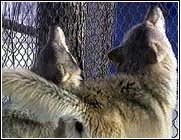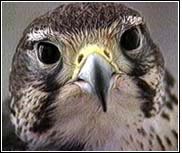 |
 |
|

Writer's Box|LinksURLs|Fractals|3Bs|Note|Freedom|Search|CatInHat
 |
Editor's Note
past issue
I wanted to bring this to your attention.
Recovering species to be dropped from endangered list
 |
|
| Gray wolf | |
Web posted May 5, 1998 by CNN.com at: 8:15 p.m. EDT (0015GMT).
WASHINGTON (AP) -- Declaring that the Endangered Species Act works, the administration says two dozen birds, plants and animals, including the bald eagle, are on their way to recovery and may soon be removed from the law's protection.
The proposal to be unveiled Wednesday by Interior Secretary Bruce Babbitt marks the first time in the law's 25-year history that such a large number of species would be earmarked for removal from the endangered list, although it would be done over two years.
Babbitt is scheduled to trumpet the proposed removal of such species as the Peregrine falcon, the bald eagle, the Eastern timber wolf and the Aleutian Canada goose during a visit to a bald eagle nesting area in a wildlife refuge near Gill, Mass.
Critics of the 1973 law claim it not only has caused widespread economic harm to landowners but has shown little evidence of protecting species since only a handful over a quarter-century have recovered enough to be left on their own.
There are 1,135 species on the list.
 |
|
| Peregrine falcon | |
Babbitt, speaking to reporters Tuesday, acknowledged that efforts to get species off the list have lagged, but he said that's in part because "we've had to dig our way out from under" a backlog of species awaiting to be listed. That backlog grew when Congress imposed a yearlong moratorium on new listings in 1995.
Since the moratorium ended in April 1996, the backlog of species awaiting a final listing decision has dwindled to about 100. The Fish and Wildlife Service is putting new priority on unlisting some of the plants that have shown significant signs of recovery.
The Interior Department announced 29 species, including animals, fish, reptiles, birds and plants, that have recovered enough to be seriously considered for removal from the endangered list. Some of the species will be downgraded to threatened and others removed from the law's protection altogether, although states may still regulate them. And some are expected to be taken off the list in certain parts of the country, but kept on elsewhere.
To remove a species from the endangered list, biologists of the Fish and Wildlife Service must first determine whether its numbers have returned to a certain level and whether it has adequate habitat for likely survival. Then a proposal is made do "delist" the species or downgrade it to "threatened." After a review period, a final decision is made on the species. All this often can take a year or more, officials said.
Since the American alligator was the first to be removed from the endangered-species list in the late 1970s, only six other species have recovered enough to be taken off the list entirely. Another 14 species were removed after they either disappeared or new information was uncovered indicating they never should have been put on the list in the first place.